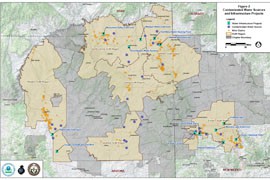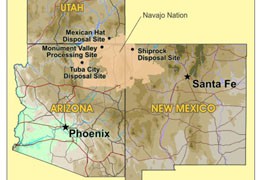Cronkite News has moved to a new home at cronkitenews.azpbs.org. Use this site to search archives from 2011 to May 2015. You can search the new site for current stories.
Agencies cite progress, work still remaining on Navajo uranium cleanup
WASHINGTON – A consortium of federal and tribal agencies reported Thursday that a five-year, $110 million project to clean up uranium contamination in the Navajo Nation had addressed the most urgent risks there.
But the report also said that in the last five years the agencies have learned much more “about the scope of the problem and it is clear that additional work will be needed.”
“All agencies are committed to continue working with the Navajo Nation to reduce the health and environmental risks and to finding long-term solutions to the remaining uranium issues on Navajo lands,” said the report, issued in response to an October request from members of Congress.
The U.S. Environmental Protection Agency, the Bureau of Indian Affairs, Nuclear Regulatory Commission, Department of Energy and Indian Health Service joined forces in October 2007 to tackle the widespread uranium contamination on Navajo lands left over from the nation’s atomic weapon production programs.
Among their accomplishments, the agencies reported that they have cleaned up nine abandoned uranium mines, rebuilt 34 homes and replaced contaminated soil at 18 sites, many near homes.
The agencies also assessed the status of 520 mines, 240 water sources and 800 homes and public structures, exceeding goals set in the five-year plan, the report said. It added that officials shut down three contaminated wells and hauled clean water to affected areas of the Navajo Nation or started projects to pipe in water.
But critics said the government has only begun to scratch the surface of the problem.
Chris Shuey, an environmental and health scientist at the Southwest Research and Information Center, said the EPA has not made progress on cleaning up any of the 520 identified abandoned mines.
Shuey, whose organization aids in nuclear waste management and uranium mining reclamation, said that the toxic materials need to be moved to a facility far from peoples’ homes, which is not happening now.
“There is a widespread cynicism that nothing is really going to be done to clean up these mines,” said Shuey, who has work with Navajo on this project.
But Shuey acknowledged that the agencies’ success in identifying the mines and affected water sources is a huge step in the right direction, and that replacing contaminated structures does benefit the people.
To really address uranium contamination on the Navajo Nation, the agencies charged with the cleanup need to include members of the community in a leadership capacity, he said. He believes that it will take more money from Congress and much more time, suggesting that there needs to be a 50-year plan, to make real progress on the problem.
“Nobody has a handle on how much this costs or how long it will last,” Shuey said. “Frustration sets in with understanding the enormity of the problem and knowing that there aren’t any more federal funds to deal with the problem.”
Navajo Nation President Ben Shelly could not be reached for comment on the report Thursday. But in a statement released by the EPA, he said that while there “have been accomplishments that improved some conditions,” Congress and the federal government still need to work to “address basic public health concerns due to the legacy of uranium mining and milling.”









